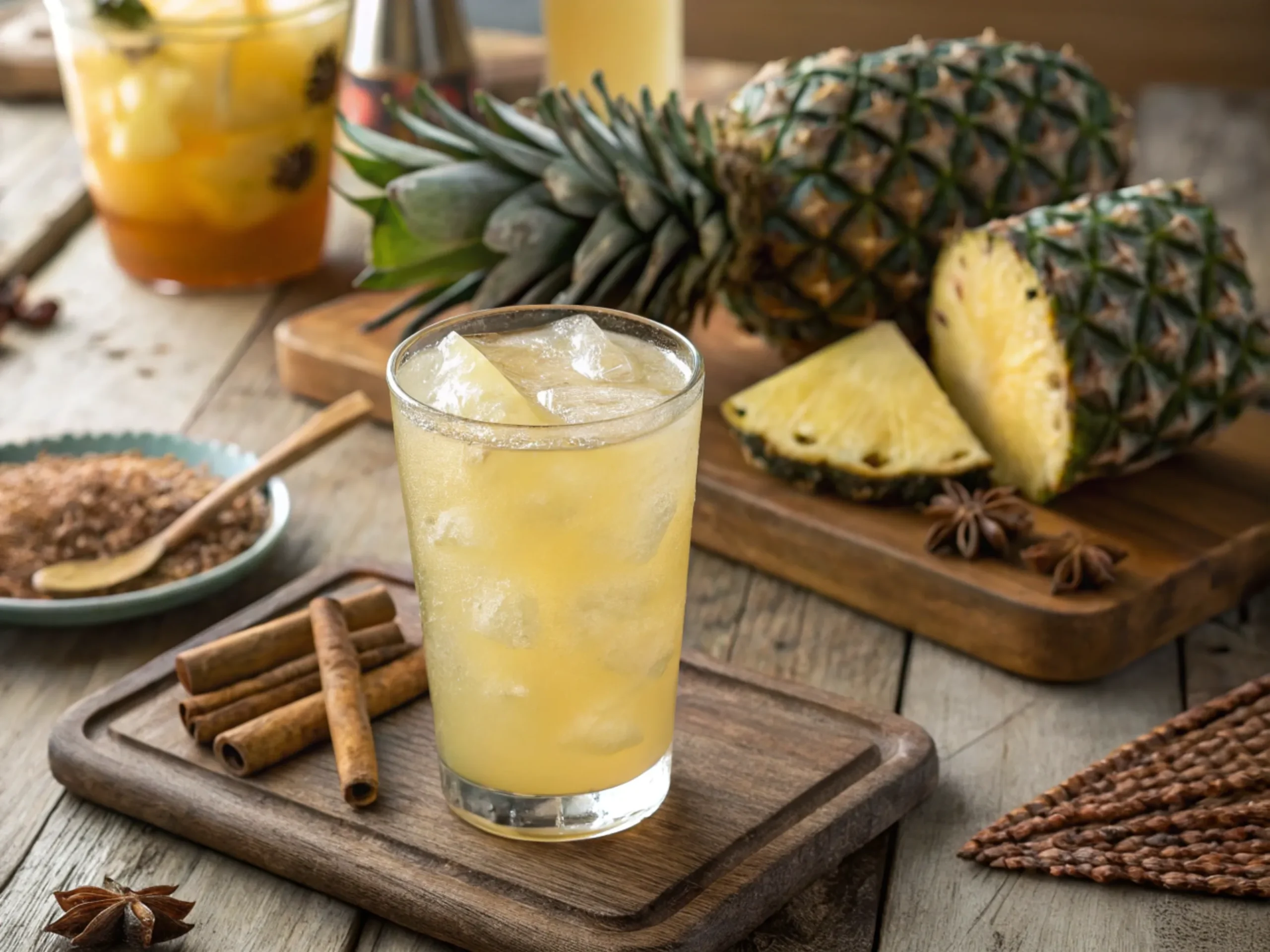Have you ever wondered what alcohol made from pineapples is called? Pineapples, with their tropical sweetness and zesty tang, are more than just a delicious fruit. They are also the base for a variety of unique alcoholic beverages. From traditional drinks like tepache in Mexico to elegant pineapple wines in Hawaii, these drinks offer a distinctive flavor and cultural significance.
This article will take you on a journey into the world of pineapple-based alcohol. You’ll learn how it’s made, what makes it special, and how to enjoy it. So, what is alcohol made from pineapples called? Let’s dive in to find out.
Table of contents
How Pineapples Are Transformed Into Alcohol
Turning pineapples into alcohol is simpler than it sounds. The process involves fermenting the natural sugars in the fruit, which are broken down by yeast. The result is a lightly fizzy, slightly alcoholic drink with a sweet-tart taste. This type of alcohol is popular in many cultures and goes by different names depending on the recipe or region.
The most famous pineapple-based alcohol is tepache. This Mexican drink is mildly alcoholic and lightly spiced, often served cold on hot days. Another popular option is pineapple wine, a smooth and refined beverage enjoyed in tropical regions. But whether it’s tepache, wine, or even pineapple beer, these drinks all start with the same basic ingredient: fresh pineapple.
Ingredients You’ll Need to Make Pineapple Tepache
Making pineapple tepache is easy. You don’t need fancy equipment or rare ingredients. Here’s what you’ll need to get started:
| Ingredient | Amount | Notes |
|---|---|---|
| Pineapple | 1 whole | Use the skin and core for extra flavor |
| Brown Sugar | 1 cup | Substitute with panela for a richer taste |
| Water | 8 cups | Filtered water is best |
| Cinnamon Sticks | 2 sticks | Adds warmth to the drink |
| Cloves | 4-5 pieces | Optional, for extra spice |
This simple list is all it takes to make a batch of tepache. The beauty of this recipe is its flexibility. You can adjust the sugar, spices, or fermentation time to suit your taste.

Step-by-Step Guide to Making Tepache
1. Clean and Prep the Pineapple
Start by washing the pineapple thoroughly. The peel is important for fermentation because it contains natural yeast. Slice the pineapple into chunks, including the core, and set aside.
2. Mix the Ingredients
Place the pineapple pieces into a large jar or container. Add the brown sugar and water, then stir until the sugar dissolves completely. If you’re using cinnamon sticks or cloves, add them now.
3. Start Fermentation
Cover the container with a clean cloth or a breathable lid. This lets air circulate while keeping dust out. Allow the mixture to ferment at room temperature for 24-72 hours. The longer it ferments, the tangier it will taste.
Pro Tip: Stir the mixture once a day to help distribute the flavors evenly and prevent spoilage.
4. Strain and Serve
When the fermentation is complete, strain the liquid to remove the pineapple chunks and spices. Chill the drink in the refrigerator and serve it over ice. Tepache tastes best fresh, so enjoy it within a week.
If you’ve ever asked yourself, “What is alcohol made from pineapples called?” tepache is one of the simplest and most delicious answers.
Other Pineapple Alcohols from Around the World
Tepache: Mexico’s Classic Drink
Tepache is a beloved street drink in Mexico. It’s slightly fizzy, mildly sweet, and full of tropical flavor. Vendors often sell it in clear plastic bags with straws, making it a refreshing treat on the go. Tepache is also a perfect match for spicy Mexican foods like tacos or enchiladas.
To explore more pineapple-inspired recipes, check out our guide to Pineapple Pie Recipes: A Tropical Dessert Adventure.
Pineapple Wine: Hawaii’s Tropical Treasure
In Hawaii, pineapple wine is a specialty drink that showcases the island’s lush produce. This wine is smoother and more refined than tepache, making it ideal for pairing with seafood or sipping at celebrations. Its bright, fruity flavor is a favorite among locals and tourists alike.
Pineapple Beer: A Creative Twist
For those who enjoy experimenting with flavors, pineapple beer is another option. This beverage combines pineapple juice with hops and grains, creating a drink that’s fruity yet balanced. It’s popular in home-brewing communities and offers a unique take on traditional beer.

Tips for Perfecting Your Pineapple Alcohol
Crafting alcohol from pineapples is straightforward, but a few tips can help you achieve the best results:
- Use Ripe Pineapples: The riper the fruit, the sweeter your drink will be.
- Keep Equipment Clean: Always sanitize your jars and utensils to avoid contamination.
- Adjust the Recipe: Experiment with different spices or fermentation times to suit your taste.
- Monitor Fermentation: Taste the drink regularly to ensure it doesn’t become too sour.
For more tropical inspiration, try our Hawaiian Banana Bread Recipe. It’s another way to enjoy the flavors of the tropics in your kitchen.
Common Mistakes When Making Pineapple Alcohol
Creating alcohol from pineapples may seem simple, but even small mistakes can lead to disappointing results. Here are the most common errors and practical tips to avoid them. By keeping these points in mind, you can ensure your pineapple alcohol turns out perfectly every time.
1. Choosing the Wrong Pineapple
The quality of your pineapple is critical. Using unripe pineapples can result in a bland, unsweetened drink, as the natural sugars essential for fermentation aren’t fully developed. On the other hand, overripe pineapples may introduce a sour or unpleasant taste. Always choose pineapples that are bright yellow, fragrant, and slightly soft when pressed. These are signs of ideal ripeness.
2. Skipping Proper Sanitation
Fermentation relies on natural yeasts, but bad bacteria can spoil the process. Dirty tools or containers can introduce contaminants that ruin your batch. Before starting, sanitize all equipment, including your jar, stirring spoon, and strainer. This step ensures a clean and safe fermentation process.
3. Over-Fermenting the Mixture
While it might be tempting to let your mixture ferment longer for stronger flavors, over-fermentation can lead to an overly sour drink. In extreme cases, it might become undrinkable. Monitor your tepache or wine daily, and taste it as it ferments. This way, you can stop the process at the right time to achieve the flavor you want.
4. Improper Storage
Once fermentation is complete, storing your drink incorrectly can affect its taste and shelf life. Always transfer your pineapple alcohol to a sealed container and refrigerate it immediately. Proper storage prevents over-fermentation and keeps the drink fresh for up to a week.

5. Ignoring Fermentation Conditions
Temperature plays a key role in fermentation. If the room is too cold, the process will slow down or stop entirely. Conversely, high temperatures may cause over-fermentation or spoilage. Keep your jar in a cool, dark place with consistent temperatures between 68–75°F (20–24°C) for best results.
Pro Tips & Creative Variations
Making alcohol from pineapples, whether it’s tepache or wine, allows for plenty of creativity. Experimenting with ingredients and techniques can help you create a drink tailored to your preferences. Here are some expert tips and exciting variations to try.
Pro Tips for Perfect Pineapple Alcohol
- Use Fresh Spices: If adding spices like cinnamon or cloves, make sure they’re fresh. This will enhance the overall aroma and flavor.
- Start Small: If you’re new to fermentation, begin with a small batch. This minimizes waste if something goes wrong and helps you refine your technique.
- Taste Test Regularly: Check the flavor of your drink daily during fermentation. This ensures you stop the process at the perfect time.
Exciting Variations to Try
- Tropical Fusion Tepache: Add mango, passion fruit, or papaya to your pineapple base for a tropical twist. This creates a rich, multi-fruit flavor that’s perfect for summer.
- Honey-Infused Tepache: Replace some or all of the sugar with honey. This gives your drink a deeper, more complex sweetness.
- Spicy Tepache: Add a slice of fresh chili or a sprinkle of cayenne pepper to the fermentation jar. The heat pairs beautifully with the sweetness of the pineapple.
- Non-Alcoholic Version: For those avoiding alcohol, simply reduce the fermentation time to one or two days. This will produce a fizzy, flavorful drink without significant alcohol content.
For more inspiration on using pineapples creatively, check out Canned Pineapple vs. Fresh. This guide explores the differences and best uses for each type of pineapple.

The History and Cultural Significance of Pineapple Alcohol
Pineapple-based alcoholic drinks have deep roots in many cultures, particularly in tropical regions where pineapples grow abundantly. Understanding the history of these drinks adds an extra layer of appreciation when making and enjoying them.
Tepache: A Mexican Tradition
Tepache originated in Mexico, where it was initially made using corn. Over time, pineapples became the star ingredient due to their natural sweetness and tropical flavor. Tepache is now a beloved street beverage, often sold in large barrels by vendors. Its mildly fizzy, lightly spiced taste makes it a refreshing choice on hot days, especially when paired with spicy Mexican dishes like tacos and enchiladas.
Pineapple Wine: Hawaiian Elegance
Hawaii is known for its pineapple wine, a drink that captures the island’s lush, tropical essence. This wine is often served at celebrations or alongside seafood dishes. The bright, fruity notes of pineapple wine make it a favorite among locals and tourists alike. Its production has also become a source of pride for the islands, showcasing their agricultural richness.
Modern Innovations
In recent years, modern twists on traditional pineapple alcohols have emerged. Pineapple beer, for instance, combines the tropical flavor of pineapple with the bold bitterness of hops. Cocktails like pineapple mojitos and pineapple margaritas have also become popular, blending tradition with contemporary tastes.
To explore more tropical desserts, check out What Is Pineapple Pie Made Of?. It’s another way to enjoy the versatility of pineapples.
FAQs About Pineapple Alcohol
Below are answers to common questions about pineapple alcohol, covering everything from preparation to storage. Whether you’re a beginner or a seasoned fermenter, these FAQs will provide helpful insights.
What Alcohol Is Made from Pineapple?
Drinks like tepache, pineapple wine, and pineapple beer are all made from pineapple. Each drink involves fermenting the fruit’s natural sugars, creating a refreshing beverage with tropical flavors.
What Is Pineapple Alcohol Called?
The name depends on the drink. Tepache is a traditional Mexican drink made from fermented pineapples, while pineapple wine is a popular option in Hawaii. Pineapple beer is another variation gaining popularity.
What Alcohol Uses Pineapple?
Pineapple is a key ingredient in many alcoholic drinks, from classic cocktails like piña coladas to infused rums and vodkas. It’s also commonly used in fermentation-based beverages like tepache.
Is Tepache Safe to Drink?
Yes, tepache is safe as long as it’s made with clean equipment and fresh ingredients. Its low alcohol content makes it a great option for casual consumption.
Can You Make Pineapple Alcohol Non-Alcoholic?
Absolutely! You can reduce the fermentation time to one or two days to produce a fizzy, flavorful drink with minimal alcohol content.
What Is the Shelf Life of Pineapple Alcohol?
Homemade pineapple alcohol is best consumed within a week. Store it in the refrigerator to maintain its freshness and prevent over-fermentation.

Conclusion
Alcohol made from pineapples, such as tepache and pineapple wine, is a delightful way to enjoy this tropical fruit. From its cultural roots in Mexico and Hawaii to modern variations like pineapple beer, these drinks showcase the pineapple’s versatility and charm. With the tips, recipes, and variations shared in this guide, you can create your own pineapple alcohol and enjoy the flavors of the tropics at home. So, what is alcohol made from pineapples called? It’s a taste of tradition, innovation, and pure tropical bliss.

